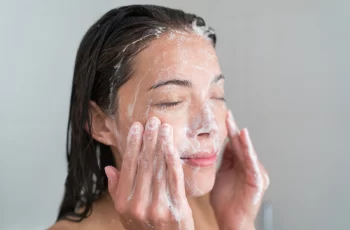
Can I use salicylic acid over primer?
It’s no secret that a well-developed skincare routine can affect the way your makeup looks. We’ve received a few questions recently about using skincare ingredients with makeup. Some of you may be surprised to learn that your skincare routine can change how your makeup applies to your skin, how it looks on your skin, and how long it stays on your skin.
With that in mind, we’re going to explore whether or not you can use salicylic acid over primer. Before we dive in, let’s quickly review what salicylic acid is and how it benefits your skin.
What is salicylic acid?
Salicylic acid belongs to the beta-hydroxy acid (BHA) family and is most commonly used in skincare formulas.
Often favored by those with blemish-prone and oily skin types.
Works to remove dead skin cells on the surface, which can build up and develop into blackheads, whiteheads, and other blemishes.
Exfoliates your skin to improve dull complexion for brighter, more radiant skin.
Its smaller molecular size means it can reach the lower layers of the skin to remove excess sebum, dirt, bacteria, and other impurities from your pores.
Salicylic acid has antimicrobial properties and can be used to clear active spots and blemishes from your skin by removing bacteria and reducing redness.
It can be included in a variety of skincare formulas, from cleansers to serums.
If you want to learn more about salicylic acid, you can read a blog post we wrote about smart BHAs.
Can you wear makeup over salicylic acid?
Yes, you can. As I mentioned before, there are many types of product formulas that contain BHAs for daily use. Be it cleansers, exfoliating toners, serums, or spot treatments. All of these can be used as usual before applying makeup. Just make sure the product has enough time to fully absorb into the skin.
When using large amounts of salicylic acid for a spot treatment, be careful not to apply it all over your face, but apply it directly to the blemish and wait for it to dry slightly. Try to avoid applying too much of the formula to the skin around the blemish as this can dry out and over-irritate the skin.
As I mentioned before, salicylic acid is a powerful acne-fighting ingredient. Not only does it neutralize redness, it also reduces swelling and regulates sebum production. This allows your makeup products like foundation, concealer, and even primer to last longer and without any signs of sliding off your skin.
Should I use a primer if I have acne?
Yes, absolutely. In fact, many people with oily and blemish-prone skin benefit from using a primer on their face instead of a moisturizer. This is because moisturizer formulas, unless they are water-based and have a light gel consistency, can sometimes be filled with comedogenic ingredients that can clog pores, causing the skin to become congested and breakouts to appear. Many people prefer to swap moisturizer for a primer because it provides a great alternative and ensures that your foundation applies smoothly and seamlessly to the skin, leaving behind a flawless finish.
Just a little warning: some primer formulas are filled with silicones, which are common ingredients but can cause pores to become clogged with excess product, bacteria, and other pollutants. To prevent further breakouts, after removing your makeup, cleanse your face with a cleanser that is packed with active ingredients that work deep into the pores to exfoliate the skin’s upper surface, leaving the skin deeply clean and makeup-free.
What is the best way to use salicylic acid?
There are a variety of ways to incorporate salicylic acid into your daily routine. Many people find that using a cleanser containing BHA is the best way to benefit from the acid. This is because formulas such as cleansers or face washes rinse off the skin, which means it avoids irritation on the surface. Perfect for those who are just starting to use the ingredient in their daily routine. For those who are building up a tolerance to salicylic acid, a serum may produce the best results.
Salicylic acid can also increase your skin’s sensitivity to light. So be sure to apply an SPF of 30 or higher every day to protect yourself from damage caused by free radicals, such as UV radiation, pollution, and other environmental aggressors. Alternatively, you can wait until your evening skincare routine to use a serum. This allows the salicylic acid to work on your face without you having to worry about free radicals. The next morning, you’ll wake up feeling clearer and with an overall healthier complexion.
How do I prevent foundation from clogging my pores?
The best way to prevent foundation from clogging your pores is to avoid using a heavy formula. While it may be tempting to opt for a full-coverage foundation, the best way to achieve full coverage without clogging your pores is with sheer and light coverage. Apply an even amount of product to your skin, then use a brush or sponge to gently buff any areas that need more coverage. This helps to build coverage without making your face look caked-on.
With this lighter coverage and product, it’s easier to cleanse your skin and remove all traces of foundation, dirt, and other impurities. While makeup remover wipes are considered quick and easy, they don’t completely cleanse the skin. For best results and to prevent foundation from clogging your pores, use a cleanser and apply with your hands to work the product into your skin before wiping it off with a clean, damp flannel or muslin cloth. Then wipe with a cotton pad soaked in exfoliating toner, then moisturize your skin again with a hyaluronic acid-rich serum.
If you have any other questions about using salicylic acid through primer, follow us on Instagram for more information.


